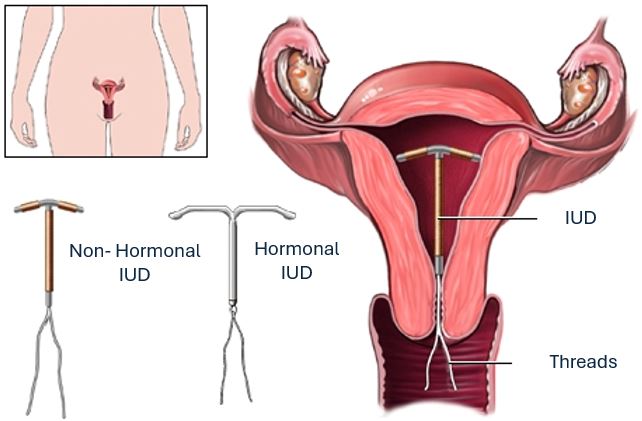Insertion or removal of an intrauterine device
An intrauterine device (IUD) is placed in the uterus to prevent pregnancy. The IUD is usually T-shaped and contains medically pure copper, a silver compound, or corpus luteum hormone.
IUD containing copper or silver compounds affects sperm and egg motility, reduces the ability of sperm to fertilize an egg.
Hormonal ESV makes the lining of the uterus too thin for pregnancy; seals the secretion of the cervical canal in such a way that it is difficult for the spermatozoa that fertilize the egg to enter the uterus; reduces sperm motility in the uterus and fallopian tubes; rarely, ovulation may also be missed.
IUD is suitable for women
- who want long-term pregnancy prevention
- who for some reason cannot or does not want to use birth control pills
- who are breastfeeding
- hormonal IUD is suitable for women with heavy periods
IUD is not the first choice of contraceptive for nulliparous women
The contraceptive effect of IUD is manifested immediately after installation. Prior to IUD installation, tests for sexually transmitted diseases and a LBC test are necessary. IUD installation is slightly painful. Local pain relievers are used during the installation to relieve pain. The best time to insert an IUD is during menstruation, but this does not have to be the rule. Postpartum, it is recommended to install IUD from 6-8 weeks after delivery. Lower abdominal pain may occur for a short time after IUD installation. To relieve pain, it is recommended to use over-the-counter pain relievers. It is not recommended to have intercourse for a few days after IUD placement if there is bleeding. In the first months after IUD insertion, periods may be heavier than usual and last longer.
IUD must not be inserted
in case of acute inflammation of the genitals, vague vaginal bleeding, blood clotting disorders and copper-containing IUD in case of copper allergy. It is necessary to consult a doctor before installing an IUD.
Possible complications
- Very rarely, inflammation of the pelvic organs can occur after the installation of the IUD device, which appears within 10 days after the installation of the IUD. If you should develop a fever with lower abdominal pain during this period, contact the Fetal Ultrasound Center at 6566162 or 5210046.
- Uterine perfotration during IUD placement, resulting in the IUD penetrating the uterine wall or passing through the uterine wall. Since the procedure is performed under ultrasound control, this complication occurs very rarely and is revealed immediately during the procedure.
- The exit of the IUD from the uterus. Uterine muscle contractions during menstruation can push the IUD out of place. Therefore, after the installation of the IUD, it is necessary to check the presence of the IUD in the uterus after the next menstruation and thereafter once a year.
- Pregnancy. Occurs very rarely. If you are pregnant and want to keep the pregnancy, it is recommended to remove the IUD. At the same time, the risk of spontaneous abortion and premature birth increases. It is also possible to get an ectopic pregnancy while wearing ESV.
In the case of IUD, it is necessary to adhere to the period of use
After the expiration date, the IUD must be removed and, if necessary, replaced with a new one. It is recommended to remove IUD during menstruation. Removal is easy and painless. Fertility is restored after IUD removal. Pregnancy is possible during the next menstrual cycle.
The price of the procedure includes the doctor's consultation fee

